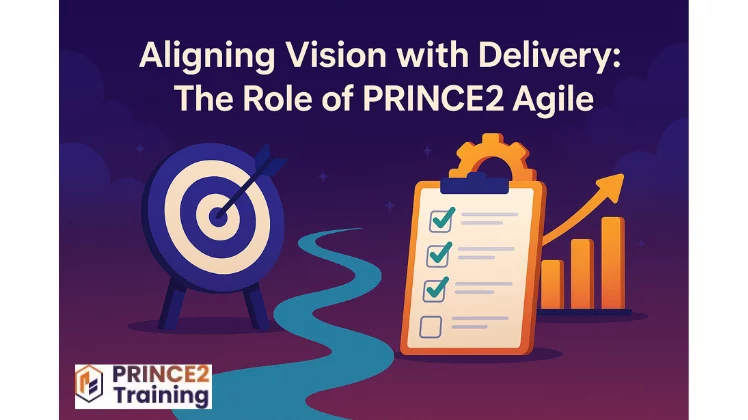How many times do projects start out with big ambitions but lose their way halfway through? Perhaps the team changes its emphasis, the priorities alter, or the end product just doesn’t match the original goals. Does this sound familiar? The gap between vision and delivery is more prevalent. This is where an organised yet flexible strategy matters.
With a PRINCE2 Agile Course, you can stay on track with your strategic goals while also being able to adapt to change as it happens. It’s not a matter of choosing between control and agility; it’s about finding a balance between the two. Let’s look into how that alignment works.
Table of Contents
- Understanding PRINCE2 Agile
- Why Alignment Between Vision and Delivery Often Fails
- How PRINCE2 Agile Bridges the Gap
- Core Features of PRINCE2 Agile That Support Alignment
- Conclusion
Understanding PRINCE2 Agile
PRINCE2 Agile is a way to manage projects that combine the strict rules of PRINCE2 with the adaptability of agile delivery methods. A project manager can use agile methods and still keep an eye on the business case, long-term goals, and risk management.
PRINCE2 Agile doesn’t get rid of frameworks to be more flexible. Instead, it finds a way for both to work together. By making roles, stages, and tolerances clear, the goal is to give the client what they really want while staying in charge. It’s great for projects where things change all the time, but the goals stay the same.
Why Alignment Between Vision and Delivery Often Fails
Many projects have a clear business goal at the start, but as they go on, they lose sight of it. This could happen for a number of reasons. There may be pressure on teams to finish things quickly, which can make them focus only on short-term goals. Over time, parties may lose interest, which can make it hard to talk to each other. The original plan might not be considered or made better as the project goes on.
The delivery process can get off track if there isn’t a set plan to help people decide what to do and keep things on track. All these things make stakeholders unhappy, prevent goals from being met, and waste resources.
How PRINCE2 Agile Bridges the Gap
PRINCE2 Agile actively pushes people to link the “why” of a project with the “how” of getting it done. It gives you tools to keep the strategic aim and the delivery reality from getting too far apart.
The “continued business justification” principle is one of the main ways it uses to achieve this. Every choice made about a project is based on whether it still fits with the business case. Backlogs and user stories are agile tools that, along with the stage gates of PRINCE2, guarantee that delivery stays true to the initial vision while still being able to change.
Project boards are still active, serving as a link between strategic stakeholders and agile delivery teams. This makes sure that comments, requests for changes, and course corrections are all handled in a way that keeps the strategy aligned.
Core Features of PRINCE2 Agile That Support Alignment
PRINCE2 Agile has a number of built-in capabilities that work together to keep the vision and execution in sync. Here are the most important features:
Focus on the Business Case
PRINCE2 Agile keeps the business case at the centre of the project, unlike many other delivery-focused methods. It is used to check every sprint, release, or change. If the business case gets weaker, the project is put on hold or stopped. This stops teams from ‘just delivering’ to make progress.
Use of Agile Concepts Within a Controlled Framework
PRINCE2 Agile keeps the main rules of PRINCE2 and adds important agile methods like Lean Startup, Scrum, and Kanban. It doesn’t tell teams what to do, but it does tell them to find the best way to get things done within the limits that have been set. This means that teams don’t have to worry about things getting out of hand when they hear criticism or when goals change.
Clarity in roles and working together
The structure makes jobs very clear, which avoids confusion, wasted time, and duplication. It also encourages the project board, client representatives, and agile delivery teams to work together. PRINCE2 Agile helps people make decisions quickly and hold themselves accountable by making roles clear.
Tailoring and Flexibility
You can change PRINCE2 Agile to fit your needs. Teams can change responsibilities, documents, and processes to fit the scale and difficulty of the project. This flexibility makes sure that even small teams or projects that change quickly may stay organised without becoming bogged down by too much bureaucracy.
Conclusion
PRINCE2 Agile helps with both strategic clarity and delivery excellence as it combines structure and flexibility. Businesses can keep their eyes on their long-term goals while managing the constant changes. Consider PRINCE2 Training to better understand PRINCE2 Agile and lead projects with more confidence and control.

Lexy Summer is a talented writer with a deep passion for the art of language and storytelling. With a background in editing and content creation, Lexy has honed her skills in crafting clear, engaging, and grammatically flawless writing.



